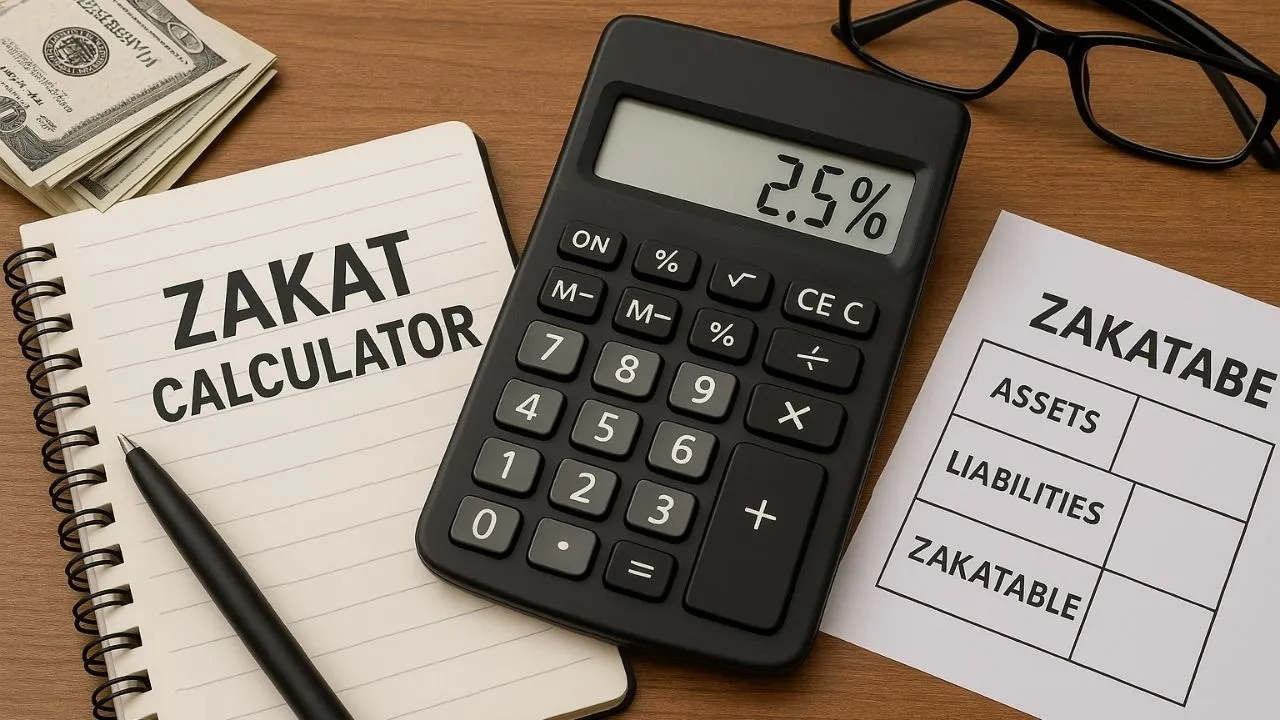Zakat is one of the five pillars of Islam, a mandatory act of worship that involves giving a portion of your wealth to those in need. Calculating Zakat accurately is essential to fulfill this religious obligation. Below, we’ve created a Zakat calculator with detailed guide to help you determine how much Zakat you owe, no matter where you live.
Zakat is a fixed percentage (2.5%) of your savings and wealth that you must donate annually if your total wealth exceeds the Nisab threshold. The Nisab is the minimum amount of wealth a Muslim must possess before they are obligated to pay Zakat.
Zakat Calculator in 2025 with Step by Step Guide
Zakat Calculator 2025
Zakat Calculation Formula
Zakat = 2.5% × (Total Savings + Investments + Gold/Silver + Other Assets – Liabilities)
Step-by-Step Guide for Zakat Calculation
1. Determine the Nisab Threshold
The Nisab is based on the value of 87.47 grams of gold or 612.35 grams of silver. You can use either value, but most scholars recommend using the silver standard as it is lower and ensures more people can fulfill their Zakat obligation.
- Current Value of Gold (per gram): Check the latest gold rate in your local currency.
- Example (India): ₹8,600/gram.
- Nisab (Gold) = 87.47 grams × ₹8,600 = ₹7,52,242.
- Current Value of Silver (per gram): Check the latest silver rate in your local currency.
- Example (India): ₹100/gram.
- Nisab (Silver) = 612.35 grams × ₹100 = ₹61,235.
Note: If your total wealth exceeds the Nisab threshold, you are obligated to pay Zakat.
2. Calculate Your Total Assets
Add up the value of all your assets that have been in your possession for at least one lunar year (Hawl).
- Cash in Hand and Bank Accounts: Include savings, fixed deposits, and any cash you own.
- Example : ₹2,00,000
- Gold and Silver: Calculate the market value of gold and silver jewelry, coins, or bars you own.
- Example : 100 grams of gold × ₹8,600 = ₹8,60,000
- Investments: Include stocks and other investments.
- Example : ₹3,00,000
- Business Inventory: If you own a business, include the value of your inventory.
- Example : ₹1,50,000
- Other Assets: Include any other assets like property (if not for personal use), loans you’ve given, etc.
- Example : ₹50,000
Total Assets = ₹2,00,000 + ₹8,60,000 + ₹3,00,000 + ₹1,50,000 + ₹50,000 = ₹15,60,000
3. Subtract Your Liabilities
Deduct any outstanding debts or liabilities that you owe.
- Loans or Debts: Include personal loans, any debt, or any other financial obligations.
- Example : ₹2,00,000
Net Wealth = Total Assets – Liabilities = ₹15,60,000 – ₹2,00,000 = ₹13,60,000
4. Check if You Exceed the Nisab
Compare your net wealth to the Nisab threshold.
- If using the silver Nisab (₹61,235):
- ₹13,60,000 > ₹61,235 → You are obligated to pay Zakat.
5. Calculate Zakat (2.5% of Net Wealth)
Multiply your net wealth by 2.5% to determine your Zakat amount.
- Zakat = 2.5% × ₹13,60,000 = ₹34,000
Who is Eligible to Receive Zakat?
Zakat can be given to the following categories of people (as mentioned in the Quran, Surah At-Tawbah 9:60):
- The poor (Al-Fuqara) – Those who have no or very little means of income.
- The needy (Al-Masakeen) – Those who have some income but it is not enough for their basic needs.
- Zakat administrators – Those who collect and distribute Zakat.
- Those whose hearts need reconciliation – New Muslims or those inclined towards Islam.
- Freeing captives/slaves – To help in the freedom of enslaved individuals.
- Those in debt – People burdened by debt but unable to repay it.
- For the cause of Allah (Fi Sabilillah) – For spreading Islam, Dawah, and legitimate Islamic causes.
- Stranded travelers (Ibn-us-Sabeel) – Travelers who are stranded and unable to return home.
Who Cannot Receive Zakat?
- Wealthy individuals who have more than the Nisab amount.
- One’s own parents, children, and spouse (Zakat cannot be given to those whom you are financially responsible for).
- Sayyids (descendants of Prophet Muhammad ﷺ) according to the majority of scholars.
- Building mosques, hospitals, or schools (Zakat is meant for individuals in need, not for public infrastructure).
Zakat must be given with the intention of fulfilling this Islamic obligation and should be distributed correctly to maximize its benefits.
Checkout : Indian Halal Stock List 2025
Important Notes
- Lunar Year (Hawl): Zakat is due on wealth held for a full lunar year (approximately 354 days).
- Personal Use Items: Items like your home, car, or personal clothing are not included in Zakat calculations.
- Gold and Silver: Only gold and silver held as investments are subject to Zakat. Personal jewelry is exempt according to some scholars, but others include it. Consult a trusted scholar for clarification.
- Timing: Zakat is typically paid during Ramadan, but it can be paid at any time of the year once it becomes due.
Example Summary (Using Indian Rupees)
- Total Assets: ₹15,60,000
- Liabilities: ₹2,00,000
- Net Wealth: ₹13,60,000
- Zakat (2.5%): ₹34,000
Paying Zakat is not just a financial obligation but a spiritual act of purification and compassion. By calculating and distributing your Zakat accurately, you contribute to uplifting those in need and fulfilling your duty as a Muslim.
If you need further assistance or have specific questions, feel free to reach out to a trusted Islamic scholar or use our Zakat Calculator tool on www.halalfinance.co.in for quick and accurate calculations.
May Allah accept your Zakat and bless your wealth. Ameen!

